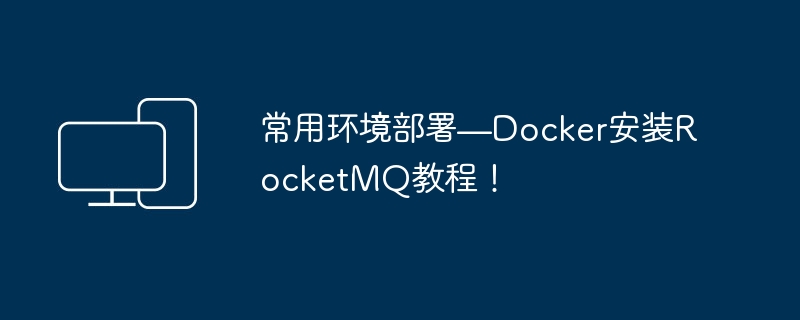 Computer Tutorials
Computer Tutorials
 Computer Knowledge
Computer Knowledge
 Common environment deployment—Docker installation RocketMQ tutorial!
Common environment deployment—Docker installation RocketMQ tutorial!
Common environment deployment—Docker installation RocketMQ tutorial!

The process of installing RocketMQ in Docker is as follows:
-
Create a Docker network:
Execute the following command in the terminal to create a Docker network for communication between containers:docker network create rocketmq-network
Copy after login -
Download the RocketMQ image:
Execute the following command in the terminal to download the RocketMQ Docker image:docker pull rocketmqinc/rocketmq
Copy after login -
Start the Name Server container:
Execute the following command in the terminal to start the Name Server container:docker run -d --name rmqnamesrv --net rocketmq-network -p 9876:9876 rocketmqinc/rocketmq:latest sh mqnamesrv
Copy after login -
Start the Broker container:
Execute the following command in the terminal to start the Broker container:docker run -d --name rmqbroker --net rocketmq-network -p 10909:10909 -p 10911:10911 -e "NAMESRV_ADDR=rmqnamesrv:9876" -e "ROCKETMQ_BROKER=broker-a" rocketmqinc/rocketmq:latest sh mqbroker -c ../conf/broker.conf
Copy after login -
Verify RocketMQ installation:
Use the following command to enter the Broker container’s shell:docker exec -it rmqbroker sh
Copy after loginInside the container, execute the following command to verify the RocketMQ installation:
cd /opt/rocketmq/bin/sh mqadmin topicList -n rmqnamesrv:9876
Copy after login
By following the above steps, you can successfully install and deploy RocketMQ in Docker. Please note that the above commands only provide a basic installation and configuration process, and the specific configuration and usage can be further adjusted according to your needs. Make sure you have installed and configured the Docker environment before executing the command.
The above is the detailed content of Common environment deployment—Docker installation RocketMQ tutorial!. For more information, please follow other related articles on the PHP Chinese website!

Hot AI Tools

Undresser.AI Undress
AI-powered app for creating realistic nude photos

AI Clothes Remover
Online AI tool for removing clothes from photos.

Undress AI Tool
Undress images for free

Clothoff.io
AI clothes remover

Video Face Swap
Swap faces in any video effortlessly with our completely free AI face swap tool!

Hot Article

Hot Tools

Notepad++7.3.1
Easy-to-use and free code editor

SublimeText3 Chinese version
Chinese version, very easy to use

Zend Studio 13.0.1
Powerful PHP integrated development environment

Dreamweaver CS6
Visual web development tools

SublimeText3 Mac version
God-level code editing software (SublimeText3)

Hot Topics
 How to exit the container by docker
Apr 15, 2025 pm 12:15 PM
How to exit the container by docker
Apr 15, 2025 pm 12:15 PM
Four ways to exit Docker container: Use Ctrl D in the container terminal Enter exit command in the container terminal Use docker stop <container_name> Command Use docker kill <container_name> command in the host terminal (force exit)
 How to copy files in docker to outside
Apr 15, 2025 pm 12:12 PM
How to copy files in docker to outside
Apr 15, 2025 pm 12:12 PM
Methods for copying files to external hosts in Docker: Use the docker cp command: Execute docker cp [Options] <Container Path> <Host Path>. Using data volumes: Create a directory on the host, and use the -v parameter to mount the directory into the container when creating the container to achieve bidirectional file synchronization.
 How to check the name of the docker container
Apr 15, 2025 pm 12:21 PM
How to check the name of the docker container
Apr 15, 2025 pm 12:21 PM
You can query the Docker container name by following the steps: List all containers (docker ps). Filter the container list (using the grep command). Gets the container name (located in the "NAMES" column).
 How to restart docker
Apr 15, 2025 pm 12:06 PM
How to restart docker
Apr 15, 2025 pm 12:06 PM
How to restart the Docker container: get the container ID (docker ps); stop the container (docker stop <container_id>); start the container (docker start <container_id>); verify that the restart is successful (docker ps). Other methods: Docker Compose (docker-compose restart) or Docker API (see Docker documentation).
 How to start mysql by docker
Apr 15, 2025 pm 12:09 PM
How to start mysql by docker
Apr 15, 2025 pm 12:09 PM
The process of starting MySQL in Docker consists of the following steps: Pull the MySQL image to create and start the container, set the root user password, and map the port verification connection Create the database and the user grants all permissions to the database
 How to update the image of docker
Apr 15, 2025 pm 12:03 PM
How to update the image of docker
Apr 15, 2025 pm 12:03 PM
The steps to update a Docker image are as follows: Pull the latest image tag New image Delete the old image for a specific tag (optional) Restart the container (if needed)
 How to create containers for docker
Apr 15, 2025 pm 12:18 PM
How to create containers for docker
Apr 15, 2025 pm 12:18 PM
Create a container in Docker: 1. Pull the image: docker pull [mirror name] 2. Create a container: docker run [Options] [mirror name] [Command] 3. Start the container: docker start [Container name]
 How to view the docker process
Apr 15, 2025 am 11:48 AM
How to view the docker process
Apr 15, 2025 am 11:48 AM
Docker process viewing method: 1. Docker CLI command: docker ps; 2. Systemd CLI command: systemctl status docker; 3. Docker Compose CLI command: docker-compose ps; 4. Process Explorer (Windows); 5. /proc directory (Linux).





